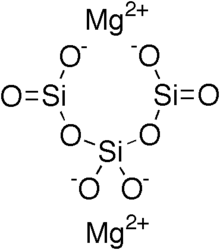Magnesium trisilicate
Magnesium trisilicate is an inorganic compound that is used as a food additive. The additive is frequently used by fast food chains to absorb fatty acids and extract impurities formed while frying edible oils.[1] It has good acid neutralizing properties, but the reaction appears too slow to serve as an effective non-prescription antacid.[2]
 | |
| Names | |
|---|---|
| Preferred IUPAC name
Dimagnesium dioxido-bis[(oxido-oxosilyl)oxy]silane | |
| Identifiers | |
| |
3D model (JSmol) |
|
| ChEMBL | |
| ChemSpider | |
| ECHA InfoCard | 100.035.509 |
PubChem CID |
|
| UNII |
|
CompTox Dashboard (EPA) |
|
| |
| |
| Properties | |
| Mg2O8Si3 | |
| Molar mass | 260.857 g·mol−1 |
| Appearance | White crystals |
| Odor | Odourless |
| Hazards | |
| R-phrases (outdated) | R36, R37, R38 |
Except where otherwise noted, data are given for materials in their standard state (at 25 °C [77 °F], 100 kPa). | |
| Infobox references | |
Health effects
On March 12, 2007, Chinese health authorities seized and halted the use of magnesium trisilicate at Shaanxi Province KFC franchises, suspecting it to be a possible carcinogen.[3] As a response, China's Ministry of Health conducted tests at six outlets of KFC.[4] The results showed chemicals in the cooking process at KFC restaurants in the country were not harmful.[5] The Ministry of Health said tests showed that using the product to filter cooking oil had no apparent impact on health. Food scares regularly sweep the Chinese media.[6]
References
- Alamgir, A. N. M. (2018), Therapeutic Use of Medicinal Plants and their Extracts: Volume 2: Phytochemistry and Bioactive Compounds, Progress in Drug Research, 74, Springer, p. 377, ISBN 3319923870
- Washington, Neena (1991), Antacids and Anti Reflux Agents, CRC Press, p. 6, ISBN 0849354447
- "Suspect additive found in KFC". Xinhua News Agency. March 12, 2007.
- "Chinese Health Ministry Okays KFC". Medindia. March 14, 2007.
- "China officials clear KFC". QSRweb. March 14, 2007. Archived from the original on November 14, 2011. Retrieved September 22, 2011.
- "China officials clear KFC after food scare". Reuters. March 13, 2007.